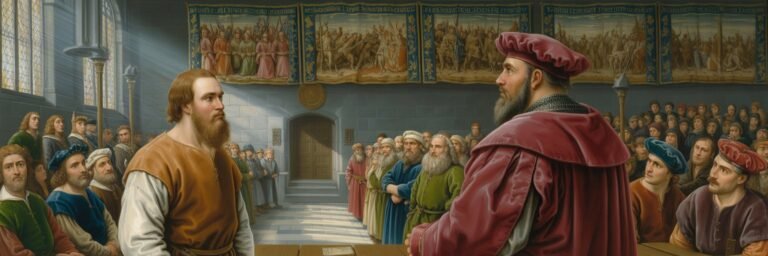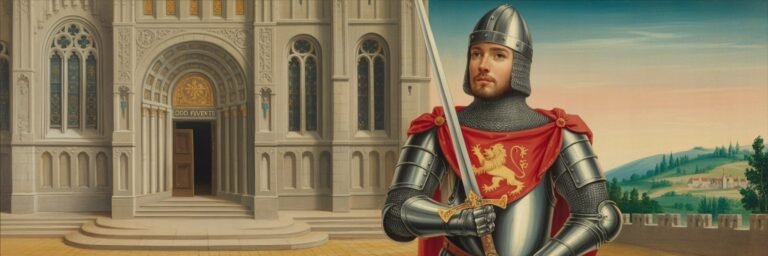INTRODUCTION
The Middle Ages: a period of history teeming with intrigue, steeped in lore and fringed with mythical edges emerged between the collapse of the Roman Empire and the dawn of the Renaissance. A time often dismissed as the murky shadow of the fabled antiquity, it is an era marked by the tales of chivalry and sagas, far from the glamorous chronicles of ancient grandeur. But to relegate the Middle Ages to the margins of historical oblivion is to overlook the profound impact its artistic and architectural traditions have left reverberating through the ages. At the epicenter of this medieval creativity lies an enigmatic duality – the architecture and the art of the era, beautifully interlaced in a cultural dance that defined European aesthetics for centuries to follow.
HISTORICAL BACKGROUND
The architectural stage of the Middle Ages gradually unfolds amid the crumbling remnants of Roman grandeur, as kingdoms strive to rise from the ashes of a fallen empire. Around the 5th century, as the Early Middle Ages commenced, Christian basilicas emerged as a significant architectural innovation inspired by Roman structures. This trend continued until the Merovingian period in northern Europe and the Ostrogothic period in Italy.
The architectural narrative truly takes flight with the transformation of the European landscape brought about by the Romanesque and Gothic styles. Known for their rounded arches, heavy volumes and extensive use of stonework, Romanesque buildings were distinctive. As the name suggests, the style incorporated elements from Roman antiquity but blended them with Byzantine and Oriental influences. Meanwhile, the shift to the Gothic style came about during the Late Middle Ages, i.e., 12th century onwards, showcasing pointed arches and intricate details, featuring monumental cathedrals as its pièce de résistance, such as the Notre-Dame Cathedral in Paris and Chartres Cathedral.
THEORIES AND INTERPRETATIONS
As the architectural legacy of the Middle Ages garners widespread academic interest, several theories emerge to dissect its intricacies. Panofsky’s theory posits that the shift from Romanesque to Gothic architecture represented a significant transformation in how medieval societies engaged with spiritual realities. This transition, he argues, reflected a shift towards an opulent celebration of the divine.
Another interpretation, notably supported by scholars such as White, emphasizes economic and social factors. According to this theory, the rise of prosperous towns led to the construction of larger buildings requiring new architectural techniques which eventually culminated in the Gothic style. These interpretations offer insightful perspectives into the zeitgeist of the Middle Ages that shaped its architectural narratives.
MYSTERIES AND CONTROVERSIES
The Middle Ages witnessed its fair share of mysteries and controversies reflected in the realm of architecture and art. Primarily, the process of how medieval masons achieved such structural marvels without modern engineering remains a quintessential paradox attracting countless theories.
Controversy also stems from various interpretations of architectural symbolism. While some attribute the intricate embellishments in Gothic architecture to worship-oriented motivations, others suggest that these designs were intended to recount biblical narratives and aid religious indoctrination.
SYMBOLISM AND CULTURAL SIGNIFICANCE
The Middle Ages marked a profound era where religion primarily shaped culture, invariably reflecting in the realm of art and architecture. The symbolism imbued in architectural elements tells tales of medieval societies’ spiritual beliefs. Striking features such as the rose window, labyrinth designs on cathedral floors, and sculpted imagery of biblical and historic figures represented spiritual enlightenment, path to salvation, and the moral compass guiding daily life, respectively.
Similarly, art reflects religious devotion and moral instruction. Altarpieces, stained glass windows and narrative frescoes imbued holy stories and religious mysticism into the essences of medieval structures, adding an ethereal quality to the architectural backbone.
MODERN INVESTIGATIONS
Modern investigations into medieval art and architecture often incorporate cutting-edge technology, including 3D reconstruction, to better understand the era’s technology and craftsmanship. Significant research conducted at historic sites such as the Cluny Abbey and Mont Saint Michel in France have enhanced our understanding of original construction methods, materials, and purpose.
Most recently, the devastating fire at Notre Dame Cathedral sparked significant interest in examining medieval engineering, inspiring worldwide calls for preservation. This has catalyzed debates around the authenticity of restoration, the value of historical continuity, and the relationship between medieval design and modern interpretation.
LEGACY AND CONCLUSION
Despite occasional mischaracterizations, the Middle Ages bequeathed an enduring architectural and artistic legacy, deeply engrained in the European cultural fabric. Its influence echoes not only in subsequent artistic movements but also in modern perceptions of community, spirituality, and civic representation.
And yet, the legacy of the Middle Ages is not constrained by the borders of time or geography. It continues to inspire contemporary minds, encouraging rigorous academic discussion, influencing creative spheres, and challenging our approach to preservation and interpretation. Amid these numerous threads of influence and debate, one certainty remains – the architectural and artistic medley of the Middle Ages is far more than a mere historical curiosum. Instead, it is a pivotal chapter in the narrative of human creativity that continues to shape our world in myriad profound, beautiful, and lasting ways. From the soaring cathedrals to the minute details of a wall fresco, from the bustling medieval town square to the serene monk’s cell, the echo of the Middle Ages rings true and clear, firmly anchoring the edifice of our collective heritage.






